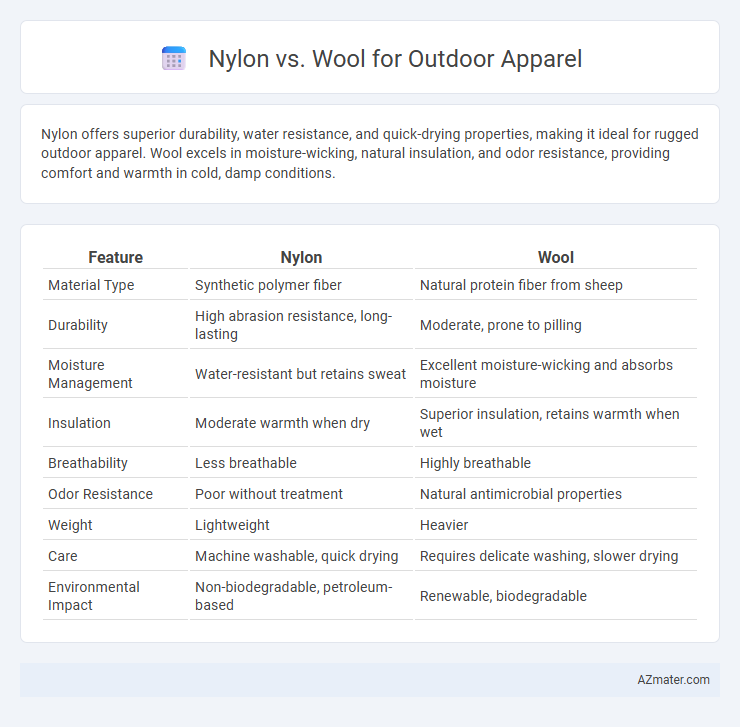Nylon offers superior durability, water resistance, and quick-drying properties, making it ideal for rugged outdoor apparel. Wool excels in moisture-wicking, natural insulation, and odor resistance, providing comfort and warmth in cold, damp conditions.
Table of Comparison
| Feature | Nylon | Wool |
|---|---|---|
| Material Type | Synthetic polymer fiber | Natural protein fiber from sheep |
| Durability | High abrasion resistance, long-lasting | Moderate, prone to pilling |
| Moisture Management | Water-resistant but retains sweat | Excellent moisture-wicking and absorbs moisture |
| Insulation | Moderate warmth when dry | Superior insulation, retains warmth when wet |
| Breathability | Less breathable | Highly breathable |
| Odor Resistance | Poor without treatment | Natural antimicrobial properties |
| Weight | Lightweight | Heavier |
| Care | Machine washable, quick drying | Requires delicate washing, slower drying |
| Environmental Impact | Non-biodegradable, petroleum-based | Renewable, biodegradable |
Introduction to Nylon and Wool in Outdoor Apparel
Nylon offers exceptional durability, water resistance, and quick-drying properties, making it a popular choice for outdoor apparel designed to withstand harsh weather conditions. Wool provides natural insulation, moisture-wicking capabilities, and breathability, ensuring comfort and temperature regulation during prolonged outdoor activities. Selecting between nylon and wool depends on the specific demands of the environment, such as exposure to moisture, temperature fluctuations, and the need for rugged performance.
Material Properties: Strength and Durability
Nylon exhibits exceptional tensile strength and abrasion resistance, making it highly durable for outdoor apparel subjected to harsh environments and frequent use. Wool offers natural elasticity and resilience, maintaining durability while providing excellent insulation and moisture-wicking properties. Combining nylon's toughness with wool's adaptive performance often results in hybrid fabrics optimized for long-lasting outdoor wear.
Moisture Management: Absorption and Drying
Nylon offers superior moisture-wicking properties, quickly pulling sweat away from the skin to keep wearers dry during intense outdoor activities. Wool naturally absorbs moisture up to 30% of its weight while maintaining insulation, but it dries slower compared to nylon, potentially leading to longer dampness. Advanced outdoor apparel often combines nylon's rapid drying ability with wool's moisture absorption to optimize comfort and temperature regulation.
Thermal Insulation and Temperature Regulation
Nylon offers excellent moisture-wicking properties and durability but provides minimal inherent thermal insulation, making it suitable as an outer layer for weather resistance rather than warmth. Wool excels in thermal insulation due to its natural crimped fibers that trap heat and regulate temperature by absorbing moisture without feeling wet, maintaining warmth even when damp. Combining wool's insulating capabilities with nylon's abrasion resistance creates an optimal balance for outdoor apparel designed for varying temperature conditions.
Comfort and Skin Sensitivity
Nylon offers moisture-wicking properties and quick drying, making it lightweight and comfortable for active outdoor wear, but it may cause irritation for individuals with sensitive skin due to its synthetic fibers. Wool, particularly merino wool, provides superior breathability, natural odor resistance, and gentle softness, reducing skin irritation and enhancing comfort for extended outdoor use. Choosing between nylon and wool depends on balancing durability and moisture management with personal skin sensitivity and comfort preferences.
Weight and Packability Considerations
Nylon excels in weight and packability for outdoor apparel due to its lightweight and compressible properties, making it ideal for ultralight backpacks and compact storage. Wool, while heavier and bulkier, offers natural insulation and moisture-wicking benefits but typically requires more space and adds weight to your gear. Prioritizing nylon enhances ease of transport and reduces fatigue on long hikes, whereas wool provides thermal comfort at the expense of packability efficiency.
Odor Resistance and Hygiene Factors
Nylon offers superior odor resistance in outdoor apparel due to its low moisture absorbency, which helps prevent bacteria buildup responsible for odors. Wool naturally excels in hygiene by possessing inherent antimicrobial properties and the ability to wick moisture away from the skin, maintaining freshness during prolonged use. Both materials provide effective odor control, but wool's natural fibers enhance breathability and comfort, making it a preferred choice for extended outdoor activities.
Environmental Impact and Sustainability
Nylon production relies heavily on fossil fuels and releases significant greenhouse gases, contributing to its higher environmental footprint compared to wool, which is biodegradable and renewable from sheep farming. Wool's carbon footprint varies depending on land management and animal welfare, with regenerative grazing practices enhancing soil health and carbon sequestration. Choosing sustainably sourced wool reduces microplastic pollution, whereas nylon fibers contribute to persistent microplastic contamination in aquatic ecosystems.
Cost Comparison: Value for Money
Nylon offers affordability and durability, making it a cost-effective choice for outdoor apparel with its resistance to abrasion and quick-drying properties. Wool, particularly merino, tends to be more expensive but delivers superior moisture management, natural insulation, and odor resistance, which can reduce the need for frequent replacements. Evaluating nylon versus wool in terms of value for money depends on activity level and climate, with nylon excelling in rugged, wet conditions and wool providing unparalleled comfort and performance for prolonged outdoor use.
Best Use Cases: When to Choose Nylon or Wool
Nylon is ideal for high-intensity outdoor activities like hiking and climbing due to its durability, water resistance, and quick-drying properties. Wool excels in cold, wet environments where insulation and moisture-wicking are critical, making it perfect for camping or winter sports. Selecting nylon ensures lightweight protection against abrasion and wind, while wool provides superior warmth and odor resistance in sustained low temperatures.

Infographic: Nylon vs Wool for Outdoor Apparel
 azmater.com
azmater.com